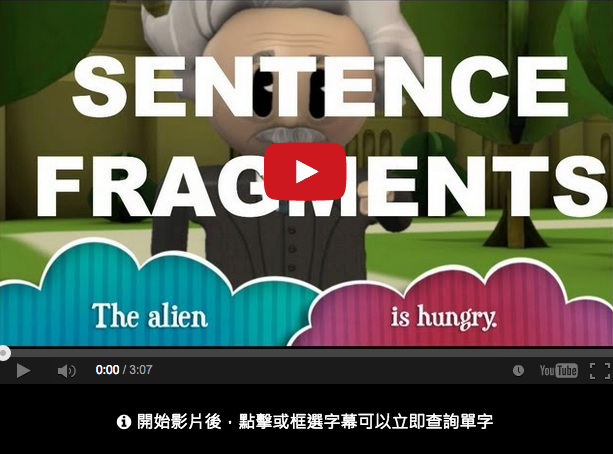延續上一篇:絕不能不會的基礎文法:超強五大句型深入剖析!(上)
今天繼續介紹剩下的三種基本句型:
◆基本句型三
此句型句子的共同特點是:謂語動詞都具有實義,都是主語産生的動作,
但不能表達完整的意思,必須跟有一個賓語,即動作的承受者,才能使意思完
整。這類動詞叫做及物動詞。
┏━━━━━━━┯━━━━━━━┯━━━━━━━━━━┓
┃S│V(及物動詞)│ O ┃
┠———————┼———————┼———————————————┨
┃1. Who│knows │the answer? ┃
┃2. She│smiled│her thanks. ┃
┃3. He │has refused │to help them. ┃
┃4. He │enjoys│reading.┃
┃5. They │ate │what was left over. ┃
┃6. He │said│”Good morning.” ┃
┃7. I│want│to have a cup of tea. ┃
┃8. He │admits│that he was mistaken. ┃
┗━━━━━━━┷━━━━━━━┷━━━━━━━━━━┷
1. 誰知道答案?
2. 她微笑表示感謝。
3. 他拒絕幫他們的忙。
4. 他喜歡看書。
5. 他們吃了剩飯。
6. 他說:“早上好!”
7. 我想喝杯茶。
8. 他承認犯了錯誤。
◆基本句型四
此句型的句子有一個共同特點:謂語動詞必須跟有兩個賓語才能表達完整
的意思。這兩個賓語一個是動作的直接承受者,另一個是動作的間接承受者。
通常這一間接承受者用一個介詞來連接,當動作的間接承受者在動作的直接承
受者之前時,這一介詞往往被省略。
┏━━━━┯━━━━━┯━━━━━━━┯━━━━━━┓
┃S│V(及物)│ o(多指人) │ O(多指物) ┃
┠————┼—————┼———————┼———————————┨
1. She│ordered │herself │a new dress.┃
┃2. She│cooked│her husband │a delicious meal. ┃
┃3. He │brought │you │a dictionary. ┃
┃4. He │denies│her │nothing.┃
┃5. I│showed│him │my pictures.┃
┃6. I│gave│my car│a wash. ┃
┃7. I│told│him │that the bus was late.┃
┃8. He │showed│me│how to run the machine. ┃
┗━━━━┷━━━━━┷━━━━━━━┷━━━━━━━━┛
1. 她給自己定了一套新衣裳。
2. 她給丈夫煮了一餐美馔。
3. 他給你帶來了一本字典。
4. 他對她什麽都不拒絕。
5. 我給他看我的照片。
6. 我洗了我的汽車。
7. 我告訴他汽車晚點了。
8. 他教我開機器。
◆基本句型五
此句型的句子的共同特點是:動詞雖然是及物動詞,但是只跟一個賓語還
不能表達完整的意思,必須加上一個補充成分來補足賓語,才能使意思完整。
┏━━━━┯━━━━━┯━━━━━━━┯━━━━━━━┓
┃ S │V(及物)│ O(賓語) │C(賓補)┃
┠————┼—————┼———————┼————————————┨
┃1. They │appointed │him │manager.┃
┃2. They │painted │the door│green.┃
┃3. This │set │them│thinking. ┃
┃4. They │found │the house │deserted. ┃
┃5. What │makes │him │think so? ┃
┃6. We │saw │him │out.┃
┃7. He │asked │me│to come back soon.┃
┃8. I│saw │them│getting on the bus. ┃
┗━━━━┷━━━━━┷━━━━━━━┷━━━━━━━━┛
1. 他們任命他當經理。
2. 他們把門漆成綠色。
3. 這使得他們要細想一想。
4. 他們發現那房子無人居住。
5. 他怎麽會這樣想?
6. 我們送他出去。
7. 他要我早點回來。
8. 我看見他們上了那輛公共汽車。
附上相關句型教學影片介紹給學習者參考:
補充單元:
但常用的英語句子並不都象基本句型這樣簡短,這些句子除了基本句型的成分不變外,通常是在這些成分的前面或後面增加一些修飾語(modifier)而加以擴大。這些修飾語可以是單詞(主要是形容詞、副詞和數詞),也可以是各種類型的短語(主要是介詞短語、不定式短語和分詞短語)。
下面以基本句型五爲例:
We found the hall full.
我們發現禮堂坐滿了。
We found the great hall full of students and teachers.
我們發現大禮堂坐滿了學生和教師。
We found the great hall full of students and teachers listening to an important report.
我們發現大禮堂坐滿了學生和教師,在聽一個重要報告。
We found the great hall full of students and teachers listening to an important report made by a comrade from the People’s Daily on current affairs in East Europe.
我們發現大禮堂坐滿了學生和教師,在聽人民日報的一位同志作有關東歐局勢的重要報告。
不同的動詞使用的句型也不盡一樣,因此在學習動詞時,應掌握動詞的類型。
以 get 爲例:
He’s getting angry. (S V C)
He got through the window.(S V M)
You’ll get a surprise.(S V O)
He got his shoes and socks wet. (S V O C)
He got himself into trouble.(S V O M)
He got her a splendid present.(S V o O)
在句子中詞類和詞的位置也影響句子的句型和意思:
I found the book easily.我很容易地找到了這本書。(S V O M)
I found the book easy.我覺得這本書很容易。(S V O C)
I have to do something. 我得做點事。
I have something to do. 我有點事做。
希望以上的五大句型介紹能對初階英文學習者有所幫助 🙂
文章轉載自:Eric’s English Lounge
Photo Source:http://goo.gl/Mo9sxj
迫不及待想馬上開始練習嗎?
快打開 VoiceTube App 練英文!
✦ 立即下載 >>> https://bit.ly/myenglishissogood
英文單字不要硬背! 藉由 VoiceTube App 看影片,不會的單字反覆聆聽,加上單字測驗練習,聽寫齊下,立刻熟記!


